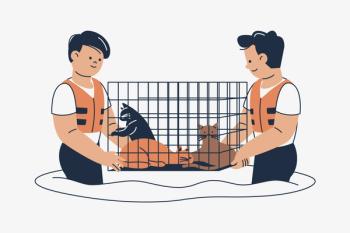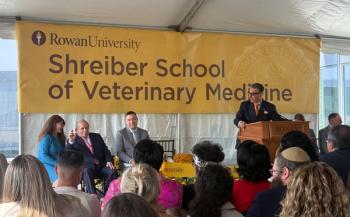
Changes in agriculture place new demands on rural veterinarians
National Report - While the shortage of rural veterinarians across the country is palpable, the number of people needed isn't.
National Report — While the shortage of rural veterinarians across the country is palpable, the number of people needed isn't.
Debt, tough working conditions, lower salaries, isolation and poor mentoring are all driving a trend that is getting more desperate.
As of September 2007, the American Veterinary Medical Association (AVMA) reported about 75 counties in the United States with more than 25,000 food animals and no veterinarians. The largest concentration of these counties was in North Dakota, South Dakota, Nebraska, Kansas, Oklahoma and Texas, with smaller pockets in Indiana, Illinois, Missouri, Arkansas and the Carolinas.
But the shortage isn't limited to those areas.
There were 217 counties with 5,000 to 25,000 food animals and no veterinarians. They are predominately east of the Mississippi stretching south from Kentucky to the East Coast, with pockets in northern North Dakota and west Texas.
In approximately 152 counties, there are no veterinarians to serve 5,000 or fewer food animals. These areas are spread throughout the country, but are mostly east of the Mississippi, from Kentucky to the Atlantic coast.
"Agriculture is changing," says Dr. Marguerite Pappaioanou, executive director of the Association of American Veterinary Colleges (AAVMC). "Where 20 or 30 years ago, there were lots of operations where there were 50, 60, 80, 100 cows or head of cattle and lots of farmers, lots of livestock owners and holders, today that has changed. There is much greater consolidation, fewer owners, fewer farms that actually own livestock. While those numbers have decreased, the size of the operations has increased."
"There is a shortage, but how big it is and how many people are needed to fill it is what is difficult to determine," Pappaioanou says.
Additionally, the strategies to stem the shortage have not been studied at length in the veterinary profession, so finding the right solution will take time, she says.
Talking to students is key, according to Pappaioanou and rural veterinarians already in the field.
But the life of a rural veterinarians isn't as bleak as often portrayed, and the stereotype is doing more harm by chasing away potential veterinarians, some say.
Dr. Brett Andrews, part owner of the Burwell Veterinary Hospital in Burwell, Neb., puts in about 50 hours a week at his 3.5-person practice, taking care of cows and calves as far as 80 miles away in one direction and 20 miles in another. Despite a six-county coverage area, Andrews finds himself downright bored at times.
"We don't spend all day driving from one call to the next," he says good-naturedly. "Our producers are big enough that when we go out there, we spend several hours. And our work is very seasonal. We're busy three months in the fall and four months in the spring. The other five months of the year, we spend a lot of time standing around looking at each other."
Nonetheless, today's rural veterinarian needs to have an understanding of food-animal diseases, epidemiology, economics, data management, prevention and a host of other skills to work with larger producers.
But that's not driving the drought, Andrews says. The shortage seems to be mostly in single-veterinarian practices, he says, especially when that one veterinarian is looking to retire.
"Graduates don't want to be solo practitioners," Andrews says. "That's where a lot of the shortage is coming from. It's partially our fault, too, for not keeping the fee schedule up. A new person coming in can't meet their debt load on the old schedule." Practitioners also need to mentor students who may be interested in becoming a rural veterinarian, Andrews says.
Loan repayment
While the federal government and several states, such as Georgia, Illinois, Minnesota, Oregon, South Dakota, Tennessee and Texas, are looking at loan repayment legislation for veterinarians who work in rural areas. The efforts will help but won't solve the problem, alone.
"Financial incentive is a big part of it," says Pappaioanou. "It's required and necessary, but it is not sufficient."
Assuming the financial relief is in place, recruitment practices, special academic programs and practitioner mentors are still needed.
All of these issues currently are being examined at veterinary colleges too. Some, like Kansas State, are introducing loan-repayment programs in exchange for working in rural areas.
Niches within niches
Life as a rural veterinarian is anything but typical, however.
The Best of the Worst
"One thing that I've learned through my exposure to rural veterinarians while working with the Academy of Rural Veterinarians (ARV) is that it is very difficult to define a typical rural practice," says Dr. Steve McDonald of Henrietta, Texas. "I have a colleague in South Texas whose practice area more closely resembles the Third World, yet he makes a very high income. There is another who has a referral practice that only works on rodeo bulls. There are many small-animal practices in small towns, reproductive specialists of all species and swine consultants. There are solo practitioners, whom we are told will never survive, yet they continue to do so."
That doesn't mean the overworked, burnt-out practitioner scenario isn't real. But typically, those veterinarians are not members of any organization and are not inclined to update their practices, McDonald says.
"We may have a few such veterinarians in our membership, but most of our people are trying to improve their situation and they tend to resist being stereotyped," he says.
Areas lacking DVMs
Pennsylvania has been especially hard-hit by the shortage, according to state veterinarian Dr. Craig Shultz.
"We have areas in the state where veterinarians who make traditional farm calls are at such a distance, people can't really get real-time service," he says. "We have a very severe shortage, particularly in northwest Pennsylvania, which is the most rural."
Finding students with a passion and encouraging them is a start.
"We certainly have to ID students who have an interest in those areas," Shultz says. "We need to do something to offset the very, very high educational costs for these people."
Rep. Charles "Doc" Anderson of Texas is working on a loan-forgiveness program there that would encourage graduates to work in rural areas to erase school debt.
Anderson, a small-animal veterinarian in Waco, Texas, says the shortage is very real in his state.
"The problem is that a lot of these students don't come from rural settings, and a lot are female students who have a tendency not to go into food-animal practice," Anderson says. While debt-forgiveness legislation already exists in his state, it was never funded, which is what the new legislation is meant to do.
The future
While the problem is being addressed across the country, no one knows what the outcome will be.
Higher salaries in other areas of veterinary medicine are a detractor. And heavy government recruiting of rural veterinarians for public-health programs doesn't help, Andrews says.
As an ARV member, Andrews hopes the shortage is narrowing, but estimates the group won't know if its efforts are making a difference for at least four to five years.
Leaders speak out
"We are examining creative ways to help students repay their loans and remain solvent during this recession. I believe veterinarians are passionate, committed and working hard to ensure that we remain one of the more respected and effective professions."
— EMILY EATON, PRESIDENT, STUDENT AVMA UNIVERSITY OF ILLINOIS DVM CANDIDATE, CLASS OF 2009
Newsletter
From exam room tips to practice management insights, get trusted veterinary news delivered straight to your inbox—subscribe to dvm360.




